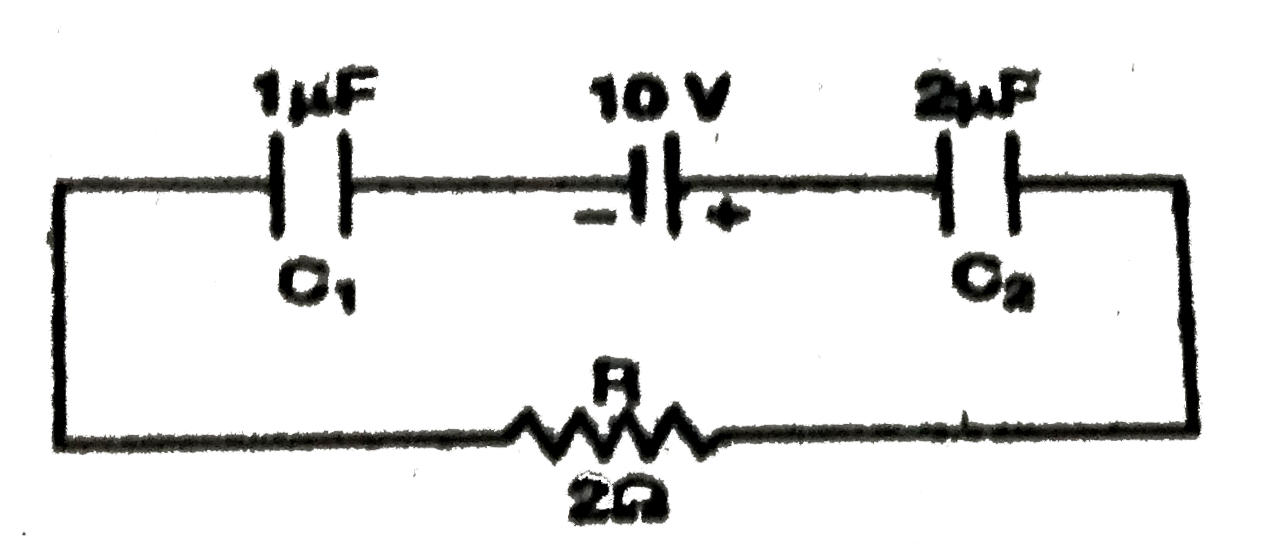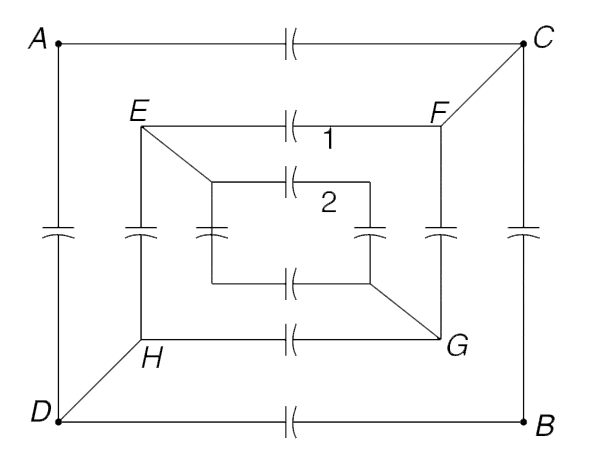At time t=0, a battery of 10 V is connected across points A and B in the given circuit. If the capacitors have no charge initially, at what time (in seconds) does the voltage across them beocme 4V? [Take:In5=1.6,In3=1.1].
![At time t=0, a battery of 10 V is connected across points A and B in the given circuit. If the capacitors have no charge initially, at what time (in seconds) does the voltage across them beocme 4V? [Take : In 5 = 1.6, In3 = 1.1]. .](https://d10lpgp6xz60nq.cloudfront.net/physics_images/JMA_CE_C13_074_Q01.png) .
.
Here, supply voltage, Vs=10volt.
Effective resistance,
R=2×22+2=1MΩ=106Ω
Effective capacitanace,
C=2+2=4μF=4×10−6F
While charging the capacitor with voltage applied, voltage across the capacitor is given by
Vc=Vs[1−e−t/RC]=10[1−e−t/106×4×10−6]
4=10[1−e−t/4]
1−e−t/4=410=0.4
e−t/4=1−0.4=0.6
−t4logee=loge0.6=loge(35)=loge3−loge5
−t4=1.1−1.6=−0.5
t=4×0.5=2s
Similar Questions
At time t=0, a battery of 10 V is connected across points A and B in the given circuit. If the capacitors have no charge initially, at what time (in seconds) does the voltage across them beocme 4V? [Take:In5=1.6,In3=1.1].
 .
.
View SolutionCalculate the effective voltage of battery connected across the given circuit, if voltage across the capacitor of capacitance 2C is V volts.

View Solution
Knowledge Check
A battery of emf 2 V and initial resistance 1Ω is
connected across terminals A and B of the circuit shown
in figure
 . AThermal power generated in the external circuit will be maximum possible when R=16/25Ω.BMaximum possible thermal power generated in the external circuit is equal to 4 W.CRatio of current through 3Ω to that through 8Ω is independent of R.DNone of above.
. AThermal power generated in the external circuit will be maximum possible when R=16/25Ω.BMaximum possible thermal power generated in the external circuit is equal to 4 W.CRatio of current through 3Ω to that through 8Ω is independent of R.DNone of above.A 10V battery is connected to two capacitors C1 and C2 and a resistor R. When the capacitors are fully charged, then the potential difference across the resistor will be
 A10 VB5VC3.33 VDzero
A10 VB5VC3.33 VDzeroA 200 V battery is connected across the combination of capacitors of capacities 5μFand10μF in series. The charge on each capacitor is
A2.667×10−4CB6.667×10−4CC2×10−4CD3×10−4C
In the circuit shown in the figure all the capacitors have capacitance C.
(a) Find the charge on capacitors marked as 1 and 2 when a battery of emf V is connected across points A and B.
(b) Find the equivalent capacitance across points C and D marked in the Figure.
(c) Find the equivalent capacitance across points E and G.

View SolutionThe switch is closed at t=0. Find time after which voltage across capacitor becomes 50 V. (take ln 2 = 0.6)

View SolutionLet q be the charge on the capacitor at any time t. The voltage V across the capacitor is
View SolutionIn the given circuit the charge on the plates of 1 μF capacitor, when 100 V battery is connected to the terminals A and B will be

View SolutionTwo capacitors of capacities 1μF and 4μF are connected in series with battery of 200V. The voltage across them are in the ratio of
View Solution
